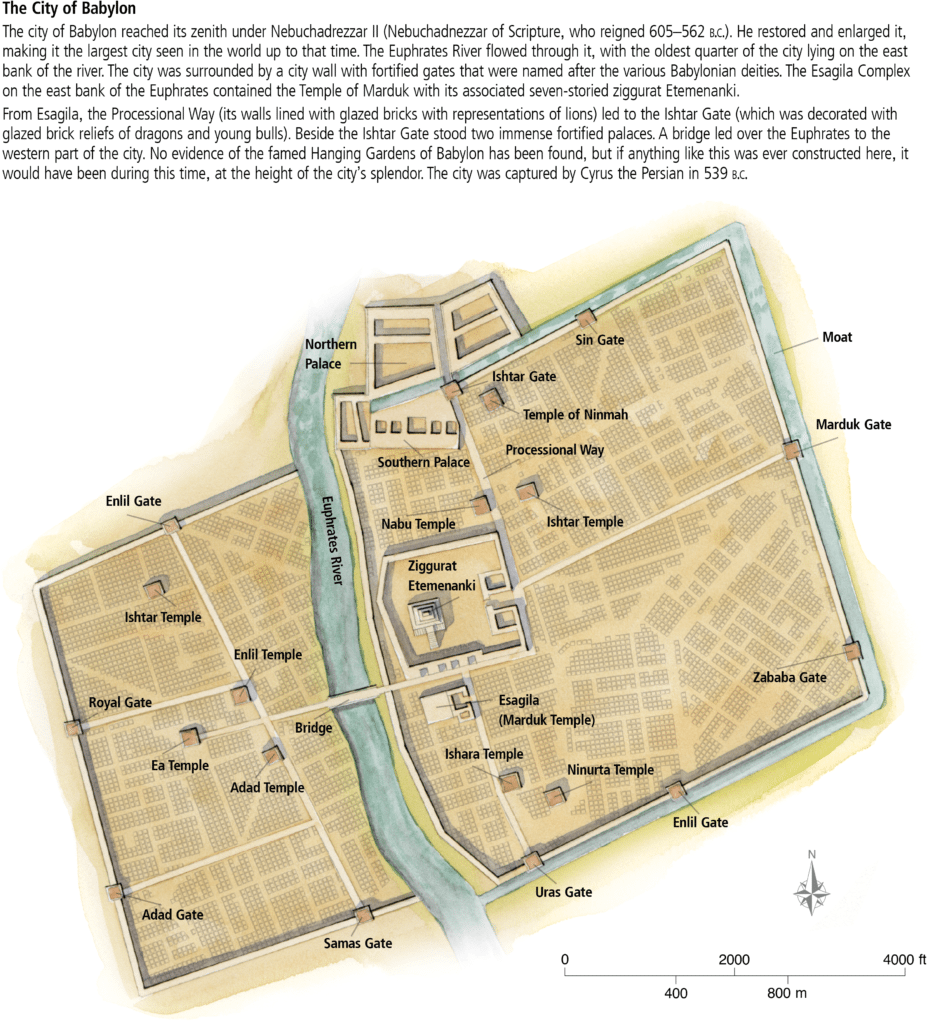Author
The book of Daniel, named after and written by Daniel in the sixth century B.C., records the events of his life and the visions that he saw from the time of his exile in 605 (Dan. 1:1) until the third year of King Cyrus (536; Dan. 10:1). Daniel, whose name means “God is my Judge,” was a young man of noble blood who was exiled from Judah during the time of King Jehoiakim (609–597 B.C.) and lived thereafter at the Babylonian court. After the fall of the Babylonian Empire, he served the Medo-Persian Empire that succeeded it.
Date
Both Jewish and Christian (cf. Matt. 24:15) tradition have held that the author of this book is Daniel, a Jew who lived during the sixth-century B.C. Babylonian exile. Many of the chapters are dated and range from the first year of Nebuchadnezzar’s reign (605 B.C.; Dan. 1:1) to Cyrus’s third year (536; Dan. 10:1). But because of its detailed prophecies of events in the middle of the second century B.C. (see ch. 11) and alleged historical inconsistencies with what scholars know of sixth-century history (see ESV Study Bible note on Dan. 5:30–31), some scholars have argued that the book must be a second-century document, from the time when Antiochus IV Epiphanes (175–164 B.C.) was oppressing God’s people. In that case, it would contain “prophecies after the fact,” put into the mouth of a famous historical character rather than being written by Daniel himself. Thus, the visions that “Daniel” saw would attempt to interpret rather than predict history. It has also been argued that the book must be dated later than the sixth century due to its language, especially the presence of Persian and Greek loanwords.
However, the facts do not require a late date. In the first place, current knowledge of sixth-century B.C. history is far from complete, and there are plausible harmonizations that explain the alleged discrepancies.
Second, the Bible asserts clearly that the Lord announces ahead of time his plans through his prophets as a means of vindicating his sovereignty and encouraging his people (see Isa. 41:21–24; 44:6–7), and there is no reason in principle why such prophecies should not be detailed and precise. Some scholars, who allow in principle that God can foretell events, nevertheless suggest that such detailed foretelling is unparalleled in the rest of the canonical prophets, and that it cannot be reconciled with the usual purpose of prediction (namely, that the first audience should be faithful to the covenant). In reply, note that Jeremiah did give a specific amount of time for the exile (Jer. 25:11; cf. note on Dan. 9:2). Further, the high degree of specificity in Daniel’s prophecies does serve its first audience as well as those to follow: this shows how carefully God has planned events and governs them for his perfect ends; therefore the faithful can recognize that none of their troubles take God by surprise, and none will derail his purpose of vindicating those who steadfastly love him. This is quite relevant to the people of God in Daniel’s day, who are on the verge of horrendous devastations and persecutions (see ESV Study Bible notes on ch. 11); they must be assured that the story will continue to its appointed fulfillment, so that they do not lose heart.
Third, there were likely Greeks and Persians present at the Babylonian court as mercenaries and in other capacities, providing a ready explanation for the presence of loanwords.
Fourth, the book of Daniel was accepted as canonical by the community of Qumran (who produced the Dead Sea Scrolls). This is telling because this group emerged as a separate party in Judaism between 171 and 167 B.C., before the proposed late date. They would not have accepted the book if it had appeared after the split.
Fifth, some who favor a later date say that the author of Daniel represented Antiochus IV Epiphanes using the figure of Nebuchadnezzar. Literary studies, however, have shown that the book of Daniel puts Nebuchadnezzar in far too positive a light (e.g., he comes to acknowledge the true God) for him to be an effective image of the relentless persecutor Antiochus IV. Of course the book’s lesson, about God’s sovereignty over even the imperial forces, would have taken a heightened relevance in the days of Antiochus IV; but that is different from saying that the book was written for that particular occasion.
There are therefore no compelling reasons to deny that Daniel wrote this book.








